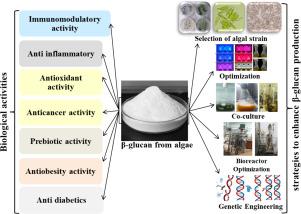挖掘藻类生产β-葡聚糖的潜力:生物特性、增产策略和未来展望综述
IF 12.5
1区 化学
Q1 CHEMISTRY, APPLIED
引用次数: 0
摘要
β-葡聚糖是一种天然存在的葡萄糖聚合物,存在于细菌、藻类、真菌和高等植物(大麦、燕麦、谷物种子)中。最近,β-葡聚糖因其多种生物作用,如抗癌、抗炎和免疫调节作用而备受关注。在全球范围内,细菌、蘑菇、酵母和谷物被用作 β-葡聚糖的传统来源。然而,由于数量少、支链结构复杂以及提取过程成本高昂,从这些来源获取β-葡聚糖具有挑战性。藻类具有独特的结构和功能优势、产量更高、生长速度更快以及可控环境下的大规模生产等优势,因此已成为替代传统来源的潜在可持续β-葡聚糖来源。此外,从微藻来源中提取 β-葡聚糖相对容易,而且不会改变 β-葡聚糖的结构。据报道,一些藻类物种(如优藻属)的 β-葡聚糖含量高于传统的 β-葡聚糖来源。本综述重点介绍了当前与藻源β-葡聚糖及其生物作用相关的研究和机遇。此外,还讨论了提高藻基β-葡聚糖生产所面临的挑战、研究差距和策略,以及在这一前景广阔的领域开展进一步研究的必要性。未来的研究可以扩展到理解β-葡聚糖发挥作用的细胞和分子机制。本文章由计算机程序翻译,如有差异,请以英文原文为准。

Untapping the potential of algae for β-glucan production: A review of biological properties, strategies for enhanced production and future perspectives
β-Glucan, a naturally occurring polymer of glucose, is found in bacteria, algae, fungi, and higher plants (barley, oats, cereal seeds). Recently, β-glucan has gained attention due to its multiple biological roles, like anticancer, anti-inflammatory, and immunomodulatory effects. Globally, bacteria, mushrooms, yeast and cereals are used as conventional sources of β-glucan. However, obtaining it from these sources is challenging due to low quantity, complex branched structure, and costly extraction process. Algae have emerged as a potential sustainable alternative source of β-glucan to conventional sources due to several advantages including unique structural and functional advantages, higher yields, faster growth rates, and large-scale production in a controlled environment. Additionally, extracting β-glucan from microalgal sources is relatively easy and can be done without altering the structure of β-glucan. Some algal species, such as Euglena spp., are reported to contain higher β-glucan content than conventional β-glucan sources. This review highlights the current research and opportunities associated with algae-derived β-glucan and their biological roles. The challenges, research gaps and strategies to enhance algae-based β-glucan production and the need for further research in this promising area are also discussed. Future research can be extended to comprehend the cellular and molecular mechanisms via which β-glucan functions.
求助全文
通过发布文献求助,成功后即可免费获取论文全文。
去求助
来源期刊

Carbohydrate Polymers
化学-高分子科学
CiteScore
22.40
自引率
8.00%
发文量
1286
审稿时长
47 days
期刊介绍:
Carbohydrate Polymers stands as a prominent journal in the glycoscience field, dedicated to exploring and harnessing the potential of polysaccharides with applications spanning bioenergy, bioplastics, biomaterials, biorefining, chemistry, drug delivery, food, health, nanotechnology, packaging, paper, pharmaceuticals, medicine, oil recovery, textiles, tissue engineering, wood, and various aspects of glycoscience.
The journal emphasizes the central role of well-characterized carbohydrate polymers, highlighting their significance as the primary focus rather than a peripheral topic. Each paper must prominently feature at least one named carbohydrate polymer, evident in both citation and title, with a commitment to innovative research that advances scientific knowledge.
 求助内容:
求助内容: 应助结果提醒方式:
应助结果提醒方式:


